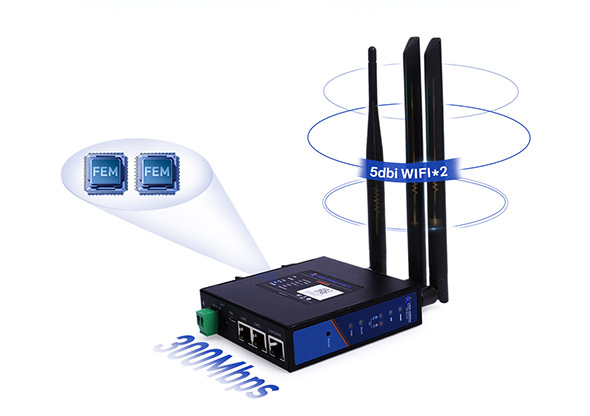In the application scenario of IIoT, the performance of IoT Router is directly related to the stability and coverage of the network. As one of the key factors affecting the signal transmission of routers, the placement of antennas directly affects the performance of the entire network system. This article will detail the placement techniques for IoT Router antennas to help those who need to optimize network performance for networking applications.
Before delving into antenna placement techniques, it is necessary to have an understanding of common IoT Router antenna types and their characteristics. The IoT Router antenna is mainly divided into two categories: directional antenna and omnidirectional antenna:
● Directional antenna:
Directional antenna has strong directionality and can concentrate signals in a specific direction for transmission, making it suitable for scenarios that require long-distance transmission or specific directional coverage. Directional antennas typically have higher gain, but their coverage is relatively limited and they require precise direction adjustment to achieve optimal results.
● Omnidirectional antenna:
The radiation intensity of an omnidirectional antenna is basically the same in all directions, enabling all-round coverage. It is suitable for scenarios with a wide coverage area and low directional requirements. However, due to the uniform distribution of signals in all directions, the gain is relatively low, and the long-distance transmission capability is limited.
1.High priority:
Try to install the antenna at a higher position if possible. The high altitud is less affected by ground obstacles, and the signal propagation path is more smooth, which is conducive to expanding the coverage area.
2.Avoid interference:
Avoid installing the antenna near electromagnetic interference sources, such as motors, transformers, and other equipment. The electromagnetic fields generated by these devices can interfere with the transmission of wireless signals and reduce signal quality.
3.Line-of-sight propagation:
Try to maintain a line-of-sight propagation path between antennas to avoid signal blockage or reflection by obstacles during transmission. If obstacles cannot be avoided, try adjusting the antenna height or direction to optimize the signal transmission path.
4.Rational layout:
For IoT Router with multi-antenna design, the antenna positions should be reasonably arranged to avoid mutual interference between antennas. At the same time, select the appropriate antenna type and gain according to actual needs to achieve the best network coverage effect.

Safety first: When placing the antenna, pay attention to comply with relevant safety regulations and operating procedures. Ensure that the antenna is installed firmly, stably, and reliably to avoid accidents.
Compliance: When selecting and placing antennas, it is necessary to comply with the regulations and policies of local radio regulatory agencies. Ensure that the parameters such as antenna type, gain, and frequency band meet the specified requirements.
Continuous optimization: The placement of antennas is not static, and it needs to be continuously optimized and adjusted based on actual usage and network environment. By regularly testing and analyzing network performance data, problems can be identified and resolved, further improving the stability and reliability of the network system.
The placement of the IoT Router antenna is one of the key factors affecting network performance and coverage. By understanding the types and characteristics of antennas, following basic placement principles, applying specific placement techniques, and paying attention to relevant matters, it is possible to optimize the layout and configuration of antennas to achieve broader and more stable network coverage. For those who need to do networking applications, these techniques will provide them with more efficient and reliable industrial IoT solutions.